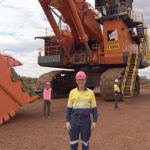2017 Haydn Williams Fellowship Public Lecture presented by Professor Brendan Murphy
Planet Earth is unique in the Solar System. It not only sustains a remarkable diversity of life forms, but also offers scenes of stunning beauty, from majestic mountains and luxuriant tropical islands to the stark splendor of desert landscapes.
The Earth has evolved over 4.6 billion years from its tumultuous and hostile beginnings to the fertile life-sustaining planet that we live on today. This evolution has happened because the Earth’s rocky outer layers have interacted with water, air and life, as well as its deep interior over billions of years.
There is an urgent and practical reason why we need to understand this evolution. If we are to practice responsible management of our planet, it is crucial that we distinguish between the kinds of global change induced by human activity and those that are part of natural cycles.
The study of the record of Earth’s evolution offers a unique and clear perspective. The study of Earth’s evolution and mountains shows its own natural rhythms, many of which profoundly influence phenomena as all-embracing as the motion and growth of continents, and the birth and destruction of oceans.
Curtin University’s 2017 Haydn Williams Fellowship Public Lecture will be presented by Professor Brendan Murphy as he explains: “Why leprechauns know how mountains form”. Professor Murphy will examine how mountains form in response to how terrestrial factors have affected the evolution of the Earth, including its climate, life and endowment of natural resources.
About Professor Murphy
Professor Brendan Murphy is from Birr, Ireland. He has been Professor of Geology at St. Francis Xavier University, Nova Scotia, Canada since 1982, having completed his BSc Geology at University College, Dublin, his MSc at Acadia University in Nova Scotia, Canada, and PhD at McGill University in Montreal, Canada.
He is now a world leader in supercontinent and orogenic (mountain-forming) research, focussing on global-scale processes related to the cyclic amalgamation and breakup of supercontinents and their relationship to the evolution of the Earth.
Professor Murphy has published more than 290 research papers. He is currently a Chief Science Editor of Geology magazine, published by Geological Society of America (GSA), the former Chief Science Editor of GSA Bulletin and Geoscience Canada, and is on several other editorial boards. He was elected fellow of the Geological Society of America in 2012, and has won national and international awards for research, service and outreach; including the prestigious Killam Research Fellowship.
Professor Murphy is currently visiting Western Australia as a Haydn Williams Fellow at Curtin University having previously had sabbaticals in Oxford, UK (1990), Berkeley, California (1996-7), UWA, Australia (2001), and Salamanca, Spain (2005).
About the Fellowship
The Haydn Williams Fellowship is offered to an academic of outstanding international reputation and broad academic interest. The appointment aims to build Curtin University’s engagement with the global academic community as well developing links between the University, industry and the community.

The history of the Western Australian School of Mines Alumni (WASMA) reflects the ups and downs of the Western Australian School of Mines (WASM) and the role it has played in supporting graduates in a range of activities and events. It also describes the important role that graduates have played in ensuring WASM remains in Kalgoorlie. Learn more.





